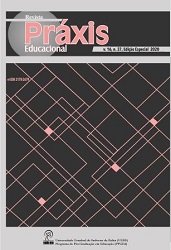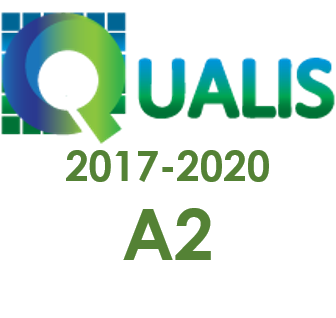MUSIC COMPUTER TECHNOLOGIES AS AN INTEGRATIVE NETWORKING EDUCATIONAL ENVIRONMENT
DOI:
https://doi.org/10.22481/praxisedu.v16i37.6433Keywords:
interactive communication, information technologies (IT), teaching methods, music computer technologies (MCT), educational environment, teaching music, technology in educationAbstract
The study is made relevant by the search for the most appropriate approaches to the pedagogical development of information technology’s new features, applicable to interactive music teaching––for example, teaching to play a musical instrument with the use of a computer program. The aim of the study is to consider interactivity, network interaction, and the implementation of educational functions as key features of music computer technologies (MCT). These technologies can help develop an effective methodology for appropriate training and new soft- and hardware systems with which students can learn three of the most important components of musical skill: the keyboard of a particular instrument, musical notation, and musical theory. The authors conclude that MCT can and should act as an interactive networking educational environment, and it is necessary to prepare a repertoire list for the educational process in such conditions, as well as to search for legal organizational forms of this activity.
Downloads
Metrics
References
Experiencing music technology: software, data, and hardware. Edit. D. Williams, P. Webster. 2nd ed. NY: Schirmer Books, 1999. 693 p.
Crawford R. (2007) Authentic Learning and Digital Technology in the Music Classroom. Victoria: Monash University [Unpublished PhD dissertation] https://trove.nla.gov.au/work/35149324?q&versionId=43654170.
Webster P. Computer-based technology and music teaching and learning. The new handbook of research on music teaching and learning. R. Colwell & C. Richardson (Eds.), NY: Oxford University Press, 2002. pp. 416-439. https://ru.scribd.com/document/382434165/The-New-Handbook-of-Research-on-Music-Teaching-and-Learning-a-Project-of-the-Music-Educators-National-Conference.
Gorbunova I. B., Chibirev S. V. (2019) Modeling the process of musical creativity. Opción, Año 35, Especial No. 22, pp. 392-409.
Gorbunova I. B., Zalivadny M. S. (2018) The Integrative Model for the Semantic Space of Music: Perspectives of Unifying Musicology and Musical Education // Problems of Music Science / Music Scholarship. № 4 (33). pp. 55-64. DOI: 10.17674/1997-0854.2018.4.055-064
Alieva I.G., Gorbunova I.B., Mezentseva S.V. Music Computer Technologies as Means of Broadcasting and Preserving Musical Folklore (as exemplified by the Russian Far East) // Issues of the Musical Science/ Music Scholarship. 2019. 1 (34). Pp. 140-149. DOI: 10.17674/1997-0854.2019.1.140-149
Jacko V. A., Choi J. Ho, Carballo A., Charlson Br., Moore J. E (2015) A New Synthesis of Sound and Tactile Music Code Instruction in a Pilot Online Braille Music Curriculum. Journal of Visual Impairment & Blindness, pp. 153-157. DOI:10.1177/0145482x1510900212.
Gorbunova I. B., Govorova A. A. (2018) Music Computer Technologies in Informatics and Music Studies at Schools for Children with Deep Visual Impairments: from the Experience. In: Pozdniakov S., Dagienė V. (eds) Informatics in Schools. Fundamentals of Computer Science and Software Engineering. ISSEP 2018. Lecture Notes in Computer Science, vol. 11169. Springer, Cham DOI: https://doi.org/10.1007/978-3-030-02750-629.
Gorbunova I.B. Music Computer Technologies in the Perspective of Digital Humanities, Arts, and Researches. Opcion. 2019. Т. 35. № S24, pp. 360-375.
Odinets V.P. Sketches on the History of Computer Science: a Study Guide in 3 vol. Vol. 3 // Syktyvkar: Komi Pedagogical Institute, 2013. Pp. 148.
Stensæth K. (2018) Music therapy and interactive musical media in the future: Reflections on the subject-object interaction. Nordic Journal of Music Therapy, Vol. 27 No. 4, pp. 312-327, DOI: 10.1080/08098131.2018.1439085.
Rating of Smartphone Manufacturers in 2019. [E-source] // https://www.itrew.ru.
Music Vision International LLC [E-source] // http://www.softmozart.com.
Petrovic-Dzerdz M., Trépanier A. (2018). Online Hunting, Gathering and Sharing – A Return to Experiential Learning in a Digital Age. The International Review of Research in Open and Distributed Learning, 19 (2). https://doi.org/10.19173/irrodl.v19i2.3732.
Calderón-Garrido D., Cisneros P., García I. D., Fernández D., de las Heras-Fernández R. (2019). La tecnología digital en la Educación Musical: una revisión de la literatura científica. Revista Electró-nica Complutense de Investigación en Educación Musical, No. 16, pp. 43-55. DOI: https://doi.org/10.5209/reciem.60768.
A. Karabanova et al. Age-Psychological and Psychological-Pedagogical Approaches to Ensuring Children’s Information Security // [E-source] // Federal Service for Supervision of Communications, Information Technology and Mass Media’s website // Available at: http://rkn.gov.ru/mass-communications/p700/p701/?print=1 / Section 9 (Access date: 12.12.2019).
Bauer W. I., Music Learning Today: Digital Pedagogy for Creating, Performing, and Responding to Music. Published to Oxford Scholarship Online: 2014. DOI:10,1093/acprof:осо/9780199890590.001.0001.
Liu M., Su S., Liu S., Harron J., Fickert C., Sherman B. (2016). Exploring 3D immersive and interactive technology for designing educational learning experiences. In Neto, de Souza R., Gomes A. S. (Eds.), Handbook of research on 3-D virtual environments and hypermedia for ubiquitous learning. Hershey, PA: IGI Global. (pp. 243–259). DOI: 10.4018 / 978-1-5225-5469-1.ch051.
Losada M., Heaphy E. (2004) The role of positivity and connectivity in the performance of business teams. American behavioral scientist, Vol. 47, No. 6, pp. 740-765.
Hernandez-Ruiz E. (2019) How is music processed? Tentative answers from cognitive neuroscience. Nordic Journal of Music Therapy, Vol. 28, No. 4, pp. 315-332, DOI: 10.1080/08098131.2019.1587785.
Schüler A. (2019) The Integration of Information in a Digital, Multi-modal Learning Environment. Learning and Instruction, Vol. 59, pp. 76-87. https://doi.org/10.1016/j.learninstruc.2017.12.005.
Gorbunova I. B., Hiner H. (2018) Music Computer Technologies and Interactive Systems of Education in Digital Age School. Proceedings of the International Conference Communicative Strategies of Information Society (CSIS 2018). Advances in Social Science, Education and Humanities Research. https://doi.org/10.2991/csis-18.2019.25.
Cremata R., Powell B. (2016) Digitally mediated keyboard learning: Speed of mastery, level of retention and student perspectives. Journal of Music, Technology & Education, Vol. 9, No. 2, pp. 145-159 (15). DOI: https://doi.org/10.1386/jmte.9.2.145_1
Plotnikov K. J. The Significance of the Artistic Repertoire for Teaching Music in a General Education School and for the Educational Process in General // Scientific research in the field of culture and education: issues and prospects. 1 // Collection of scientific articles based on the materials of the I International Conference of Young Scientists “Relevant Problems of Modern Culture and Education,” March 29-31, 2016 // Under the scientific editorship of Olesina E.P. and Przhlenskaya I.B. Moscow: Institute of Art Education and Cultural Studies of the Russian Academy of Education. 2016. Pp. 73-79.
Gorbunova I.B., Plotnikov K.Yu. Music-Related Educational Project for Contemporary General Music Education of Schoolchildren. International Journal of Innovation, Creativity and Change. Vol. 9, Issue 13, 2019, pp. 683-699.
Materials about Soft Way to Mozart system from the XIII International Academic/Practical Conference. https://www.musiceducation2.org/pages/soft-way-to-mozart-science-old, https://www.softmozart.com
Al-Shaher M.A. Assessment of M-Service Acceptance in Educational Context. Journal of Southwest Jiaotong University. Vol. 54, Issue 5, 2019, http://jsju.org/index.php/journal/article/view/369
Alasmri M., Onn W.C., Hin H.S. Social Networking Framework for Learning Motivation. Journal of Southwest Jiaotong University. Vol. 54, Issue 6, 2019, http://jsju.org/index.php/journal/article/view/450
Downloads
Published
How to Cite
Issue
Section
License
You are free to:
Share - copy and redistribute the material in any medium or format; Adapt - remix, transform, and build from the material for any purpose, even commercially. This license is acceptable for Free Cultural Works. The licensor cannot revoke these freedoms as long as you follow the terms of the license.
Under the following terms:
Attribution - You must appropriately give credit, provide a link to the license, and indicate if any changes have been made. You may do so in any reasonable way, but not in a way that suggests that you or your use is endorsed by the licensor.
There are no additional restrictions - You cannot apply legal terms or technological measures that legally restrict others to make any use permitted by the license.










